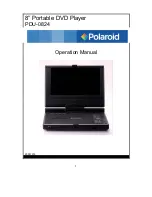
Owner’s Manual for MGG450
9
General Information
Engine Knock Intensity Screen
Engine knock, or detonation, is caused by poor fuel
quality and subsequent spontaneous ignition within the
cylinder. While most engines experience some knock
during normal operation. If severity and duration are
excessive, this can lead to engine damage. The
MGG450 is equipped with knock sensors on every
cylinder to detect and protect the engine from damaging
knock conditions.
When knocking intensity reaches 32%, the engine
controls will automatically modify timing, fuel-to-air ratio,
and other parameters to minimize the negative effects of
knock.
NOTE:
If cylinders consistently show above average
knock (32% or greater), consult your local GMP ASD.
A
B
C
D
E
001436
Figure 2-6. Knock Intensity Screen
A Max engine knock indicator (95%):
Levels of
normalized engine knock above this will cause a unit
shutdown.
B Normal engine knock indicator (<32%):
Levels of
normalized engine knock above this will cause a
warning as engine automatically adjusts.
C Engine cylinder number:
Indicates the cylinder
associated with the knocking values.
D Engine knock monitor status:
Level 0 indicates
engine has no knock. Level 1 (ON) indicates current
knock status only while unit is operating.
E
Sensor failure indicator:
Level 0 indicates all
knock sensors are functional. Level 1 indicates
knock sensor has failed (Only applies to currently
operating unit).
Ignition Secondary Voltage Display Screen
A
B
001437
Figure 2-7. Ignition Secondary Voltage Display
A
Secondary ignition voltage
B
Engine cylinder number
Setting the Controller Date and Time
To set clock on the digital controller:
1.
Press MENU.
2.
Select Setpoints>Date/Time>Time.
3.
Press ENTER.
4.
Adjust settings by using the up and down arrows.
5.
Press ENTER.
Dual Fuel System
(000168)
DANGER
Explosion and Fire. Fuel and vapors are
extremely flammable and explosive. Keep fire
and spark away. Failure to do so will result
in death or serious injury.
See
. The dual fuel system allows the unit to
run on either natural gas (primary) or LP liquid
(secondary, if equipped). In the event that the primary
source becomes unavailable, the unit will automatically
switch to the secondary source and can do so while in
operation.
IMPORTANT NOTE: Comply with all laws regulating
the storage and handling of fuels.
Summary of Contents for MGG450
Page 8: ...4 Owner s Manual for MGG450 Introduction and Safety This page intentionally left blank ...
Page 48: ...44 Owner s Manual for Generator Wiring Diagrams and Service Log DC Controls Page 2 of 6 ...
Page 49: ...Owner s Manual for Generator 45 Wiring Diagrams and Service Log DC Controls Page 3 of 6 ...
Page 50: ...46 Owner s Manual for Generator Wiring Diagrams and Service Log DC Controls Page 4 of 6 ...
Page 51: ...Owner s Manual for Generator 47 Wiring Diagrams and Service Log DC Controls Page 5 of 6 ...
Page 52: ...48 Owner s Manual for Generator Wiring Diagrams and Service Log DC Controls Page 6 of 6 ...
Page 53: ...Owner s Manual for Generator 49 Wiring Diagrams and Service Log Relay Connections ...
Page 54: ...50 Owner s Manual for Generator Wiring Diagrams and Service Log AC Connections ...
Page 55: ...Owner s Manual for Generator 51 Wiring Diagrams and Service Log Control Panel Layout ...
Page 56: ...52 Owner s Manual for Generator Wiring Diagrams and Service Log Control Faceplate ...
Page 57: ...Owner s Manual for Generator 53 Wiring Diagrams and Service Log CAN Wiring ...
Page 58: ...54 Owner s Manual for Generator Wiring Diagrams and Service Log Receptacle ...














































